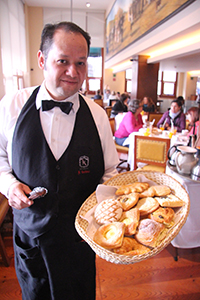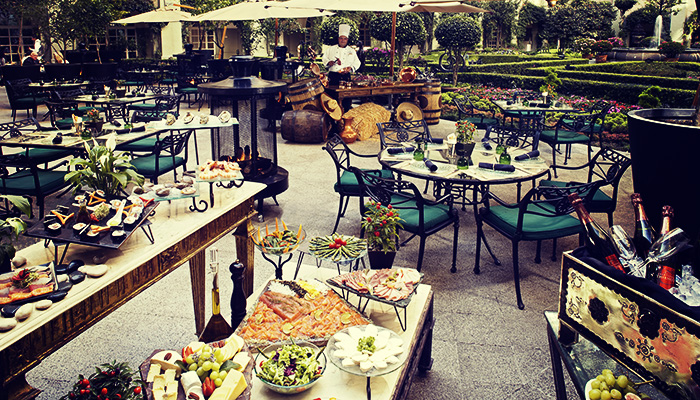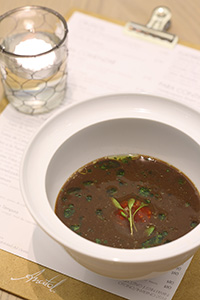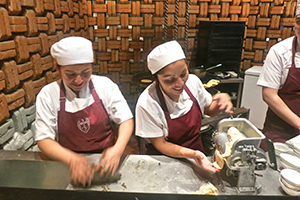
Right now, jacarandas are blooming throughout Mexico City, shedding their lavender petals like confetti. Plenty of sunshine means perfect weather for strolling through one of many outdoor markets or enjoying a meal at any number of fondas (food counters or stalls) found in every neighborhood. The Federal District has always been a culinary mecca; the rest of the world is only becoming more aware of it over the past few years. And, while you could easily leave satisfied after devouring your weight in tacos and other street snacks, there are certain restaurants that must not be missed. Here’s a short list of some of our favorites.
Pujol
Chef Enrique Olvera, who made waves in New York after opening Cosme this fall, kick-started his culinary career with the opening of Pujol nearly 15 years ago. Mere mention of the restaurant today causes locals’ eyes to widen in reverence — and for good reason. Pujol’s humble beginnings are the stuff of fairy tales. At the age of 24, Olvera scraped together enough money to start the restaurant — in fact, his modern, minimalist design was originally out of necessity — but, before long, Polanco grew into the Federal District’s most cosmopolitan neighborhood and Olvera was drawing attention from across the globe for his artful, inventive take on Mexican gastronomy. Many of those experiments have now become Pujol classics, such as his elote con mayonesa de hormiga chicatana, café y chile costeña (husked baby corn smoked inside a gourd with powdered chicatana ants, coffee and costeña chile mayonnaise) or his mole madre (an unpredictable dish made with three rare Oaxacan chiles — black, red and yellow chilhuacles — that have been fermenting for more than a year). A trip to Mexico City requires experiencing a meal at Pujol.
Anatol
Also in posh Polanco is the Forbes Travel Guide Recommended Las Alcobas, a design-savvy boutique hotel located on Presidente Masaryk Avenue, a street that has been compared to Milan’s Via Monte Napoleone or Rodeo Drive in Beverly Hills. At the bottom of the grand winding staircase is the entrance to Anatol, the hotel’s farm-to-table restaurant led by chef Justin Ermini, who brings with him experience working with Wolfgang Puck, Jean-Georges Vongerichten, the late Charlie Trotter and more. While the diverse menu includes selections ranging from veal scallopini to corned beef and chicken schnitzel, Ermini’s takes on classic Mexican dishes are the standouts. His black bean soup is like no other. He begins by toasting chilhuacle negro and pasilla chiles in duck fat before adding black beans from Chiapas, chicken stock and seasonal vegetables. Once blended to a silken consistency, it is topped with smoked foie gras, tomato seeds and cilantro gremolata. Stuffed squash blossoms are given a fun twist when stuffed with three cheeses (goat, cow and sheep) and prepared tempura-style, then drizzled with cascarillo honey and served with a grilled lemon. Fill up a bit too much at dinner? The guest rooms at Las Alcobas are just a few steps away and feature cloud-like mattresses, multihead rain showers and jetted soaking tubs with handmade soap butler service.
Contramar
Head to Contramar in Colonia Roma Norte for some of the freshest, choicest seafood in town — but do make reservations, or get there very early, because the place is only open for lunch and fills up quickly each day. The dining room is bright and breezy with pops of blue, harkening a seaside restaurant in the middle of the city. However, white tablecloths and bow-tie-donning servers hint at the price point and quality of service. Favorites include the atùn (tuna), served on tostadas or as sashimi over a Mexican sauce; seasoned fish “al pastor” tacos; pulpo a la brasa (grilled octopus); and pescado contramar (whole grilled, butterflied fish, rubbed with cilantro sauce and red chile adobo). Be sure to save room for dessert because the place is lauded for its sweets, particularly the plate of towering strawberries and meringue.
El Cardenal
While El Cardenal is a favorite amongst locals for all meals, its breakfast is an absolute must-eat-to-believe. Started as a small family business in 1969, the restaurant has now grown to four locations throughout the city. Besides the perfectly baked pan dulce (sweet, tasty buns) they’re known for preparing each morning, they make their own cream and fresh cheese (from cows milked in their own barns) and process their own corn masa to make fresh tortillas. Begin breakfast with a mug of drinking chocolate, blended tableside in a pitcher, a warm concha roll dipped in cool, creamy nata (clotted cream). After that starter, you’ll notice that the savory breakfast dishes range from the more familiar huevos rancheros and enfrijoladas to traditional plates like omelette de flor de maguey (agave flower omelet) and revueltos a la cazuela en salsa de chinicuiles (scrambled eggs served in a sauce made from ground roasted red agave worms, and topped with queso panela). However you order, you really can’t go wrong.
Reforma 500
For a brunch that doesn’t skimp on anything, opt for the champagne feast at Reforma 500 in the Four-Star Four Seasons Hotel Mexico, D.F. Mexican-born chef Edgar Kano seamlessly incorporates his Japanese heritage into the menu; at brunch, it comes through in the form of sushi and sashimi. Kano and his team also man a charcoal grill, searing choice cuts of steak, Argentinean chorizo, head-on shrimp, mahi-mahi, scallops and more — all fresh to order. A cook at an adjacent comal produces signature Mexico City quesadillas filled with your choice of items like squash blossoms, huitlacoche, chorizo and mushrooms. Other draws include tableside Bloody Marys, a live mariachi band, classic egg dishes to order and a chocolate fountain, which acts as a centerpiece for a breathtaking display of other traditional Mexican sweets and French pastries. Speaking of which, be sure to try the divine almond croissant; just one bite is all the advertisement needed for the hotel’s new bakery, Pan Dulce. But do hurry for your brunch at Reforma 500 as the restaurant is slated to close in June for a renovation project expected for completion in September.
Paxia
The best day to visit Paxia in San Angel is on Saturday, after you’ve strolled through the neighborhood’s market of handmade goods set to live music. The restaurant is split into several levels and the top looks down on an open kitchen where fresh tortillas and sopes are constantly produced. Chef Daniel Ovadia’s dining room is a dark, sleek escape from the commotion and the young chef’s cuisine is playful but extremely complex. Do plan on making an event of your meal, particularly if you opt for the highly recommended tasting menu. Current offerings include a black shrimp aguachile with burnt cocoa husks and coral huitlacoche that conjures thoughts of a Jackson Pollock painting; vegetarian “chicharrónes” topped with duck, pickled cabbage and chili sauce; and a tiny torta ahogada (pork-stuffed sandwich) that arrives with instructions on how to neatly eat it using a plastic glove. End your meal with an equally artful dessert accompanied by té de monte, a digestif made from herbs, orange, guava and piloncillo.




